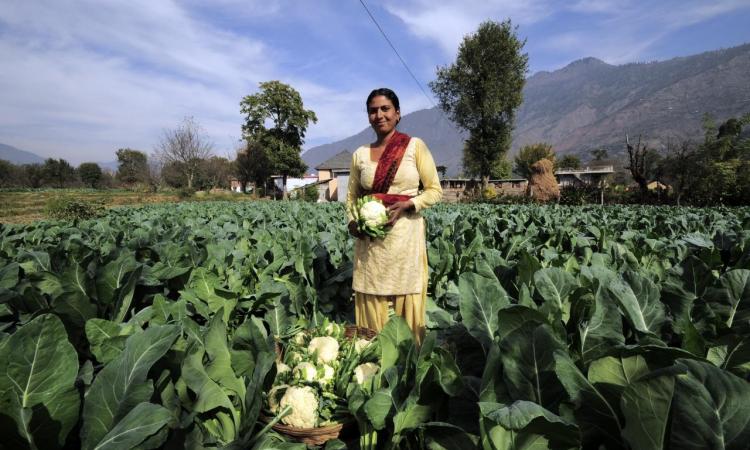
Climate change has become a major threat to agriculture and rural livelihoods and can lead to rural poverty and migration and cause overexploitation of natural resources such as water, land and forests informs this study titled 'Is crop diversification vulnerable to climate, agricultural and socio-economic factors in Himachal Pradesh, India?' published in Current Science. For example, extreme drought conditions are known to decrease household income by 25–60 percent and increase poverty by 12–33 percent in India.
Indian agriculture is highly vulnerable to climatic shocks due to its dependence on rainfall with 45 percent of the total cropped area in the country being dependent on rainfed agriculture. The frequency of climatic shocks in India has recently increased and is expected to rise further in the future.
Crop diversification can help deal with climate shocks
Adapting to these increasing risks is crucial for countries such as India and experience from other developing countries reveals that diversification of agriculture into high-value crops can greatly help in increasing incomes and adapt to the negative effects of climate shocks. Crop diversification towards high-value cash crops, including fruits and off-season vegetables, can greatly help in boosting farm incomes, increase job opportunities, and preserve land and water resources.
Crop diversification is very important for agricultural development in Himachal Pradesh (HP), India that is blessed with natural resources. The proximity of farmlands to the roadside, availability of farm labour and irrigation facilities in HP have been found to be important factors that have helped farmers diversify their crops and cultivate high-value cash crops using yield-enhancing practices and high-yielding seed varieties.
Addressing challenges like adverse climatic conditions, irrigation infrastructure, labour availability and food crop productivity are critical to achieving faster, more efficient and sustainable agricultural growth in Himachal Pradesh. The paper discusses the findings of a study that assesses the extent of crop diversification in the state and examines the factors influencing crop diversification in the state.
The study period was divided into three decades and crop diversification indices were calculated across districts in the periods of 1991–2000 (decade I), 2001–2010 (decade II), 2011–2020 (decade III) and 1991–2020 (overall). Heat-map figures were used to depict the crop diversification scenario across all districts in HP
The study found that:
Rainfall and temperature influenced crop diversification:
Increase in rainfall and the minimum temperature had a significant negative impact on crop diversification. Maximum temperatures was positively related to and increased crop diversification. This was because temperatures increased the likelihood of droughts, floods and irregular rainfall.
Irrigation and cropping intensity determined extent of crop diversification
Irrigation intensity had a negative impact on crop diversification due to poor canal management and lack of perennial rivers. Higher cropping intensity was accompanied by increased irrigation intensity. Thus, cropping intensity influenced crop diversification index positively, but irrigation intensity negatively. Crop diversification was positively correlated with cropping intensity but negatively correlated with irrigation intensity.
Cropping intensity and irrigation intensity were positively related. Despite the fact that higher cropping intensity was associated with higher irrigation intensity, crop diversification is found to be higher in districts with lower irrigation intensity. This indicates that higher cropping intensity is restricted to mono-cropping, where irrigation intensity is relatively higher, whereas it is associated with multi-cropping in the rainfed lower hill districts of HP.
High-yielding crops which use water intensively were scarcely grown in this region. High food productivity crops and varieties contributed to crop concentration rather than diversification.
Irrigation systems in the state differed depending on how water was distributed to the crops. Lift and khul irrigation promoted mono-cropping of cereals and vegetables over minor (lift and flow) irrigation.
Population density and availability of farm labour influenced diversification
Marginal and small farmers were found to focus on crop specialisation due to limited credit availability and limited access to information and communication technology. Crop diversification was influenced by population density with farmers more likely to diversify their crops with increase in population density.
Crop diversification index was positively related to cultivators and total main workers. As the number of cultivators and total main workers increased, so did the availability of labour in agriculture. As a result, more crops were grown and crop diversification increased.
The study found that while other climatic and demographic factors influenced crop diversification, the khul and lift irrigation systems that lift water from the river also influenced crop diversification. Surface water irrigation has led to overexploitation of water resources in the region. The study argues that there is need of proper management of surface irrigation with the crop calendar to reduce the stress on groundwater in the region and proper monitoring of irrigation for sustainable agriculture is essential in the region.
/articles/factors-influencing-crop-diversification-himachal-pradesh